The AMD Trinity Review (A10-4600M): A New Hope
by Jarred Walton on May 15, 2012 12:00 AM ESTAMD Trinity: Battery Life Also Improved
With all of the changes going into Trinity, one thing that hasn’t changed since Llano is the process technology. Trinity is once again coming on a 32nm process from GlobalFoundries. If we were talking about Intel, Trinity would represent a “Tock” on the roadmap—a new architecture on an existing process. We’ve looked at CPU and GPU performance, and this is a part that’s pretty much universally faster than its predecessor. Given the lengthier pipeline and Bulldozer-derived architecture, I admit that I was concerned Trinity might actually be a step back for battery life; it appears that my fears were unfounded, largely due to the improvements in Piledriver. As usual, we tested with all laptops set to 100 nits brightness in our idle, Internet, and H.264 playback tests. I also ran some additional tests which we’ll discuss in a moment. First, here are the standard battery life results:
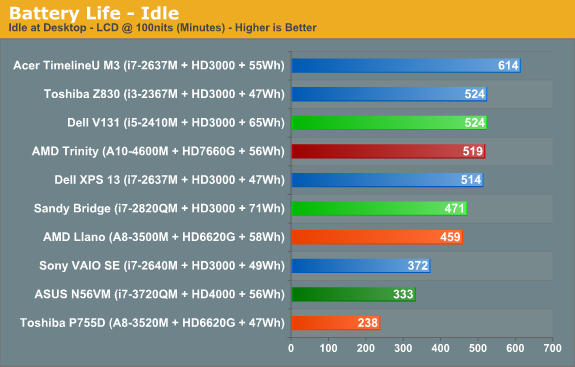
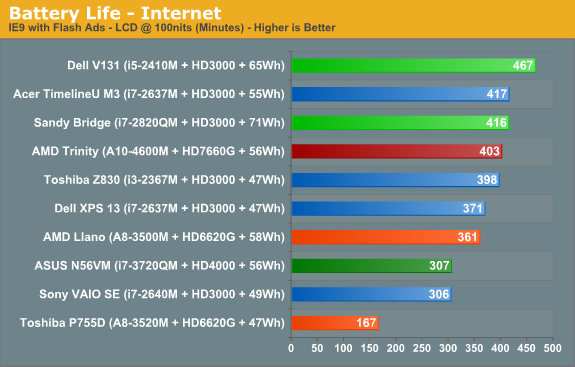
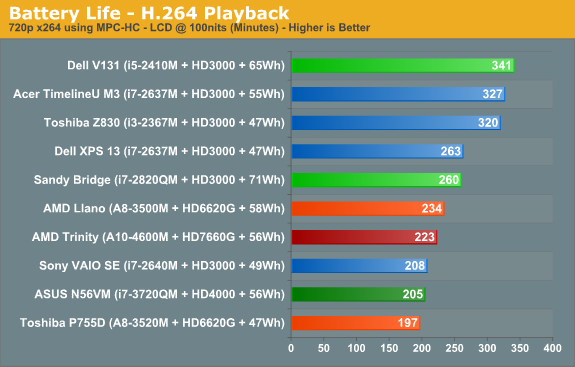
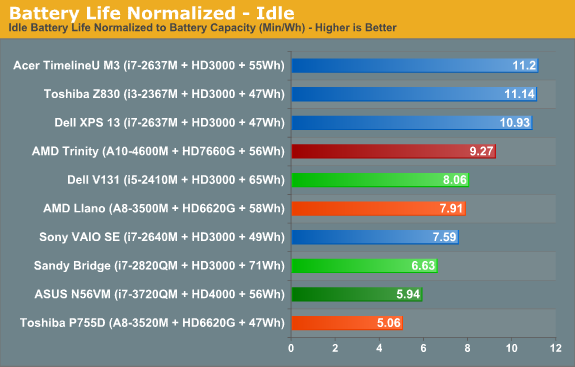

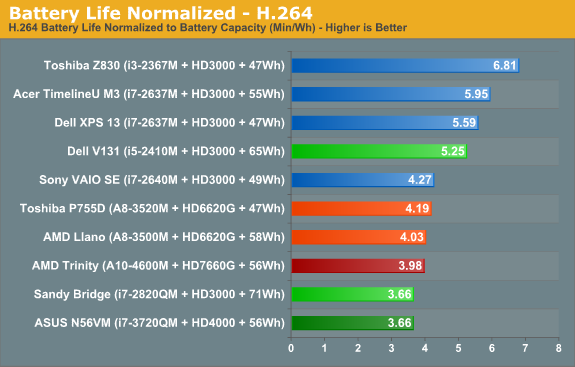
With a similar capacity battery to the original Llano laptop, and the same size 14” panel, Trinity comes out of the gates and posts two clear wins: idle battery life and Internet battery life are both up substantially relative to Llano. In fact, looking at the normalized charts, the only laptops that can consistently beat Trinity are found in Sandy Bridge ultrabooks—we won’t even bother discussing Atom or Brazos netbooks, as they’re competing in a completely different performance bracket. In something of a surprise, H.264 battery life doesn’t see the same benefit unfortunately, and it’s the one discipline where Llano still holds on to a slight lead over Trinity. Sandy Bridge meanwhile has always done very well in H.264 battery tests, and we see that with the Vostro V131 posting a normalized score that’s 30% better than Trinity and Llano. Of course, on the other end of the spectrum we have Ivy Bridge; we’ve only looked at one Ivy Bridge laptop so far, but if the pattern holds than Ivy Bridge will generally be a moderate step back in battery life relative to Sandy Bridge, giving AMD an even larger lead in this area.
We also performed a few other tests that we won’t present in graph form. One set of tests we alluded to earlier: the charts show Trinity with a Samsung 830 SSD, but we also ran tests with an Intel 520 SSD. Idle battery life dropped to 476 minutes (an 8% decrease), Internet battery life checked in at 371 minutes (down 8% again), and H.264 battery life stayed nearly the same at 217 minutes (down less than 3%). If battery life is one of your primary concerns, remember: all SSDs are not created equal!
Another test that we ran is simulated gaming; we looped the four graphics tests in 3DMark06 at 1366x768 until the battery ran out. We’ve run this same test on quite a few other laptops, and Llano initially looked to be far and away the best solution. Later, we discovered that when we tested Llano we were letting the GPU run in power saving mode—basically half the performance you’d get compared to being plugged in. We retested and measured 98 minutes, so the extra graphics performance comes with a heavy cost. We only tested Trinity (and Ivy Bridge and Sandy Bridge) using higher performance graphics settings, and this is one more area where it scores worse than Llano: Trinity managed just 77 minutes. That’s about the same as Ivy Bridge and Sandy Bridge (79 and 73 minutes, respectively), so if you’re after better gaming performance while running off the mains, you might need to keep looking.
Before getting too carried away with the above results, you still need to consider how important battery life is for your usage model. Some people travel a lot and like to go all day without plugging in; others will go from place to place and plug in whenever they’re not on the go. If you fall in the latter category, battery life isn’t usually a problem with any decent laptop, while those looking for all-day computing will definitely want as much mobility as possible. Ultimately, battery life is a factor of battery capacity as well as power optimizations done by the OEMs. We’ve seen battery life improve by as much as 50% when comparing two otherwise similar notebooks, but at least AMD’s reference platform for Trinity delivers a great starting point.
Temperatures and Acoustics
One other item we wanted to quickly touch on is system temperatures. We typically use HWMonitor and check temperatures of laptops under idle and load conditions. We did this with Trinity as well, but unfortunately the current version of HWMonitor doesn’t give us a lot of information. The only temperatures it reports are from the SSD and the HD 7660G graphics—there’s nothing about CPU core temperatures. That means we can’t provide much detail, other than to say that load temperature on the GPU topped out at 71C during extended testing, while the idle temperature was 39C. As usual, temperatures and noise levels go hand in hand, and the low 71C maximum GPU temperature matches up nicely with noise levels that never got above 37dB. It’s not the quietest laptop we’ve ever tested, and surface temperatures can get a little warm, but overall Trinity looks to be a good balance of performance and power requirements, which means quiet laptops are definitely possible.










271 Comments
View All Comments
JarredWalton - Tuesday, May 15, 2012 - link
I think it *needs* to be at $600 to sell, because SNB + GT 540M is already at $600. However, HP has hinted that their sleekbooks with Trinity will start at $600 and $700 for the 15.6" and 14" models, respectively. "Start at" and "comes with a reasonable amount of RAM and an A10 APU" are not the same thing. Until HP actually lists full specs and a price, I have to assume that the $600 price tag for the 15" model is going to be 4GB RAM, 250GB HDD, and an A6-4400 APU. Hopefully I'm wrong, but the fact is we don't know Trinity's real price yet, so in the article I'm referring to the price I think it should be at in order to provide a good value.hechacker1 - Tuesday, May 15, 2012 - link
As most people I assume are coming from the Core 2 Duo style laptops, I would like to see a comparison of trinity with that.I know core i processors are fast, but I don't know if AMD has caught up with Core 2 performance.
tipoo - Tuesday, May 15, 2012 - link
Even with Llano they had caught up, with Trinity the margin will only be larger. Use this to compare whatever you wanthttp://www.anandtech.com/bench/Product/399?vs=62
cosminmcm - Monday, May 21, 2012 - link
How about comparing Llano to a core 2 quad? And at about the same frequency.Here you go:
http://www.anandtech.com/bench/Product/399?vs=50
This Guy - Wednesday, May 16, 2012 - link
Sorry to be rude. I really think you missed the point of this chip.The CPU in Trinity is close to a 17W CPU with a 17W GPU. It performs about the same as an intel 17W chip. It's graphics engine is far better and the CPUs should cost about the same. The only real disadvantage over 17W Sandy Bridge is that in a prototype chasis Trinity uses more power, but a few watts should be shaved on production models.
This means AMD has caught up to Intel again! Yes AMD is going to lose spectacularly when ULV Ivy Bridge comes out and I doubt Trinity is going to scale at higher power but at low power, AMD has caught up!
(Yes I know that Sandy Bridge includes a GPU but if you look at your benchmarks, ULV Intel with a dGPU scores similar to Trinity when transcoding [The only really CPU limited test in this review])
ET - Wednesday, May 16, 2012 - link
Something I just read at The Tech Report: when using MediaEspresso to transcode video, the result of VCE was much smaller than QuickSync or software, yet they didn't notice a difference in quality. I would like to know what your experience was. If that's really the case I'd prefer VCE over other Intel's solution even if it's slower.Riek - Wednesday, May 16, 2012 - link
As far as i know VCE is not yet supported or been made available by AMD.All those tests are due to openCL and not VCE since that part cannot be reached at this point in time. (yes blame AMD for that one, this is already taking 6months and still their is nothing about VCE)
Spunjji - Wednesday, May 16, 2012 - link
You're mistaken, there.Quote from Page 2:
"Trinity borrows Graphics Core Next's Video Codec Engine (VCE) and is actually functional in the hardware/software we have here today. Don't get too excited though; the VCE enabled software we have today won't take advantage of the identical hardware in discrete GCN GPUs"
karasaj - Wednesday, May 16, 2012 - link
When you go to the llano review, the HD4000 gets stomped by Llano's desktop graphics offering. When you look at Trinity, the notebook version of trinity barely beats Llano. Why is it that Intel can practically fit the full power of their IGP (get nearly the same performance from notebooks as from 3770k) but AMD's is drastically weaker?Also - will we see a weaker HD4000 in the dual core/cheaper IVB variants? I think Trinity desktop GPU will stomp on the HD4000 and might actually be a viable budget gaming solution as long as CPU improvements are good enough. We could see it take down quite a bit of the discrete graphics market I think, considering the HD4000 already can do that.
JarredWalton - Wednesday, May 16, 2012 - link
It's an odd move by Intel, perhaps, but I think it makes sense. The mobile Sandy Bridge and Ivy Bridge parts basically get the best IGP Intel makes (HD 3000/4000), and what's more the clocks are just as high and sometimes higher than the desktop parts. Yeah, how's that for crazy? The i7-3720QM laptop chips run HD 4000 at up to 1.25GHz while the desktop i7-3770/K/S/T runs the IGP at up to 1.15GHz. SNB wasn't quite so "bad" with HD 3000, as the 2600K could run HD 3000 at 1.35GHz compared to 1.3GHz on the fastest mobile chips.Anyway, the reason I say it kind of makes sense is that nearly all desktops can easily add a discrete GPU for $50-$100, and it will offer two or even three times the performance of the best IGP right now. On a laptop, you get whatever the laptop comes with and essentially no path to upgrade.
For AMD, if you look at their clocks they have them cranked MUCH higher on desktops. The maximum Llano clocks for mobile chips are 444MHz, but the desktop parts are clocked up to 600MHz. What's even better for desktop is that Llano's GPU could be overclocked even further on many systems -- 800MHz seems to be achievable for many. So basically, AMD lets their GPU really stretch its legs on the desktop, but laptops are far more power/heat constrained. It will be interesting to see what AMD does with desktop Trinity -- I'd think 900MHz GPU core speeds would be doable.